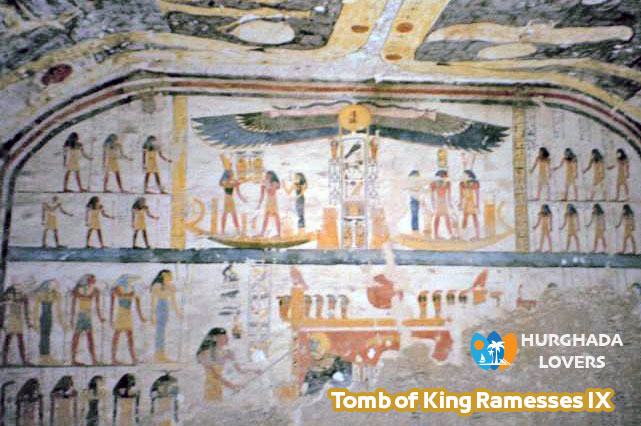Tomb of King Ramesses IX | KV6 in Valley of the Kings, Luxor, Egypt – Egyptian Tombs
Facts about Egyptian tombs, history of the Pharaonic civilization “Ancient Egypt History” and more Tomb design, visiting hours, entrance ticket prices…
It is a tomb located in the eastern valley in the Valley of the Kings area in Egypt.
The tomb shows signs of speed in implementation due to the death of King Ramses IX before its construction was completed. Learn more information about the tomb in the Ancient Egypt civilization below..
Tomb of King Ramesses IX Facts
King Ramesses IX is the eighth Egyptian Pharaohs kings of the Twentieth Egyptian Dynasty in The Ramesside Period of the The New Kingdom of Egypt, and he ruled Egypt for 18 years..
The period of rule in ancient Egypt “Ancient Egyptian Government” was somewhat difficult, as the country was suffering both economically and politically, and Agriculture in Ancient Egypt and Industry in ancient Egypt deteriorated and Ancient Egyptian science.
Perhaps this is a strong reason for not completing the construction of the tomb during the reign of Ramses IX.
His reign witnessed the spread of Pharaonic tomb robbers “Ancient Egyptian Grave Robbers” as a result of hunger and the outbreak of Revolutions in Ancient Egypt.
There are theories and evidence from Egyptology that the tomb was built at different times..
Perhaps this is due to the high costs of building the tomb and the royal court not being able to bear such expenses..
The tomb comes with a set of inscriptions indicating the development of Sculpture in Ancient Egypt and Architecture in ancient Egypt.
It also comes with a somewhat high surface, thus differing from the rest of the tombs that come from the same era..
A range of colours including black, blue and yellow were used, which are unusual colours in the surviving tombs of the Valley of the Kings..
Most of the contents of the tomb were stolen, including the king’s pharaonic Ancient Egyptian Coffins, and the king’s pharaonic Mummy has not been found yet..
Inside the tomb of King Ramses IX
The corridor, which was named Corridor “B”, contains a large group of scenes, including the king standing before the God Ra and the God Osiris, the most famous ancient Egyptian deities – Ancient Egyptian gods and Goddesses in the Ancient Egyptian religion.
There are also other pictures that are drawn very precisely, even showing details of clothing in ancient Egypt, as well as a drawing of a cobra with a lion’s head, which is a sign of authority..
Pharaonic Egyptian Cartouche were also found, as well as the text of the Hymn to Ra from Ancient Egyptian Literature, which is a hymn used in prayer to praise Ra..
There are also other drawings that refer to the priest Yun purifying Osiris and performing the ritual of opening the mouth..
On the right wall of the corridor is a picture of the king standing before God Amun-Ra and offering him incense..
The king came wearing a crown that was fully drawn to indicate his rule over the regions of Upper and Lower Egypt, as in the Geography of ancient Egypt.
While on the northern wall there is a group of manifestations that came in the first part of the Book of Caverns, which is a funerary book..
Corridor C in the tomb of King Ramesses IX
On the north wall there are inscriptions including the Hymn to Ra as well as part of the Book of the Afterlife, Book of Amduat, which is also a funerary book..
While at the bottom of the wall is a picture of King Ramses IX advancing to his tomb with the God Hathor, who holds a large plaque bearing the names of the king..
There is also another image of the king worshipping before the God Khonsu and Neferhotep, while on the right wall there is a snake and a ram-headed god..
The ceiling has detailed drawings of the polar stars, which are colored yellow to indicate the extent of Astronomy in ancient Egypt.
There is a gate at the end of the room in the corridor above which there is another picture of the king with his family during their worship..
Corridor D
The second and third hours of the Book of the Amduat are inscribed on the wall of the corridor, but they appear in abbreviated form..
On the right is a picture of the king with the God Ptah and the god Maat, the symbol of Law in Ancient Egypt. There is also a picture of the king in the form of the god Osiris..
What is meant by the previous image is the equality between the king and the god..
Next comes the room called Room H, which contains another group of inscriptions, including a picture of the priest Yun and the priest Motef..
The burial chamber inside the tomb of King Ramesses IX contains a collection of excerpts from the Book of the Earth, which are engraved on the right and left walls..
Pictures were also found explaining the journey during the night and day that the king made using solar boats, and on the left there is a picture of a group of gods..
There is also another image of the king standing in front of a decorated cabin..
The ceiling of the burial chamber is carved with images of the God Nut and also the sun disk crossing her body at night..
There is also a collection of day and night scenes on the ceiling of the burial chamber..
Note: Facts and secrets of the history will be added soon…
Hurghada Excursions Lovers, Best Travel Agency in Hurghada to provide daily tours to visit the Tourist attractions of Luxor by Hurghada to Luxor Tours and Hurghada to Pyramids Trips. Book online when you come to Hurghada, El Gouna, Sahl Hashish, Makadi Bay, Soma Bay, Egypt Tours Packages.
